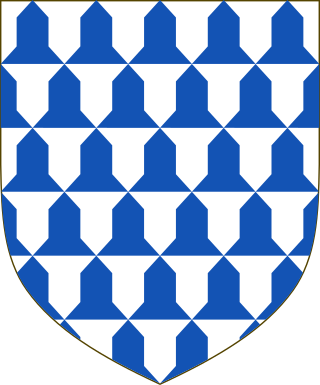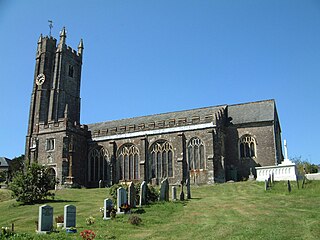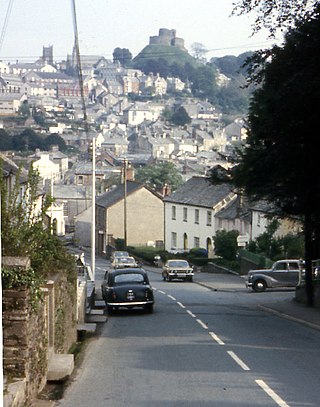| History of Cornwall |
|---|
 |
According to Sanders (1960) there were three English feudal baronies in Cornwall. [1]
| History of Cornwall |
|---|
 |
According to Sanders (1960) there were three English feudal baronies in Cornwall. [1]

John de Beauchamp, 3rd Baron Beauchamp de Somerset was an English peer.
Gilbert FitzRichard de Clare, 1st Earl of Hertford, feudal baron of Clare in Suffolk, was created Earl of Hertford by King Stephen.

William de Redvers, 5th Earl of Devon, of Tiverton Castle and Plympton Castle, both in Devon, was feudal baron of Plympton in Devon.
Richard de Redvers, 4th Earl of Devon was Earl of Devon from 1188 until his death and was feudal baron of Plympton in Devon.
Richard de Redvers, 2nd Earl of Devon was Earl of Devon from 1155 until his death and was feudal baron of Plympton in Devon. He married Denise, one of the daughters and coheiresses of Reginald, Earl of Cornwall. He was High Sheriff of Devon from 1154 to 1157. He was the son of Baldwin de Redvers, 1st Earl of Devon and brother of William de Reviers, 5th Earl of Devon.
Richard Fitz Turold was an eleventh-century Anglo-Norman landowner in Cornwall and Devon, mentioned in the Domesday Book. In the 13th century his estates formed part of the Feudal barony of Cardinham, Cornwall, and in 1166 as recorded in the Cartae Baronum his estates had been held as a separate fiefdom from Reginald, Earl of Cornwall.

Harberton is a village, civil parish and former manor 3 miles south west of Totnes, in the South Hams District of Devon, England. The parish includes the village of Harbertonford situated on the main A381 road. In the 2001 census the parish had a population of 1,285. The village is a major part of the electoral ward of Avon and Harbourne. At the 2011 census the ward population was 2,217.

John de Beauchamp, 2nd Baron Beauchamp of Somerset was an English peer and was feudal baron of Hatch Beauchamp in Somerset.
William I de Moyon, 1st feudal baron of Dunster in Somerset, was seigneur of Moyon in Normandy and became Sheriff of Somerset in 1086. He founded the English de Mohun family in the Westcountry. Recorded in the Domesday Book of 1086 as a tenant-in-chief of William the Conqueror holding a number of manors in Somerset with caput at Dunster Castle.
Humphrey III de Bohun of Trowbridge Castle in Wiltshire and of Caldicot Castle in south-east Wales, 5th feudal baron of Trowbridge, was an Anglo-Norman nobleman and general who served King Henry II as Lord High Constable of England.
Humphrey II de Bohun of Trowbridge Castle in Wiltshire and of Caldicot Castle in south-east Wales, 4th feudal baron of Trowbridge, was an Anglo-Norman nobleman, the third generation of the Bohun family settled in England after the Norman Conquest of 1066.

Humphrey I de Bohun, of Trowbridge Castle in Wiltshire, jure uxoris 3rd feudal baron of Trowbridge, was an Anglo-Norman nobleman who by his lucrative marriage became "the founder of the fortunes of his family", later prominent in England as Earls of Hereford and Earls of Essex. He is usually enumerated "Humphrey I" even though following his father he was the second "Humphrey de Bohun" settled in England. He has even been called "Humphrey the Great".
According to Sanders (1960) there were eight certain or probable English feudal baronies in Devonshire:

Launceston was one of three Feudal baronies in Cornwall which existed in the mediaeval era. Its caput was at Launceston Castle.

The Feudal barony of Trematon was one of the three feudal baronies in Cornwall which existed during the mediaeval era. Its caput was at Trematon Castle, Cornwall. In 1166 it comprised 60 knight's fees, thus about 60 separate manors.

John de Beauchamp, 1st Baron Beauchamp "de Somerset", was feudal baron of Hatch Beauchamp in Somerset. He fought in the wars in Scotland and was a signatory of the Baron's Letter to Pope Boniface VIII in 1301.

The feudal barony of Great Torrington whose caput was Great Torrington Castle in Devonshire, was one of eight feudal baronies in Devonshire which existed during the mediaeval era.
The feudal barony of Burgh by Sands, originally known as Burgh, was a feudal barony with its caput in Burgh by Sands, Cumberland, England.
The feudal barony of Bradninch was one of eight feudal baronies in Devonshire which existed during the mediaeval era, and had its caput at the manor of Bradninch. One of the notorious barons was William de Tracy, who was one of the four knights who assassinated Thomas Becket, Archbishop of Canterbury, in Canterbury Cathedral in December 1170.
The feudal barony of Totnes was a large feudal barony with its caput at Totnes Castle in Devon, England. It was one of eight feudal baronies in Devonshire which existed in the mediaeval era. The first feudal baron was Juhel de Totnes, who is listed in the Domesday Book of 1086 as possessing 107 manors or other landholdings in Devon.